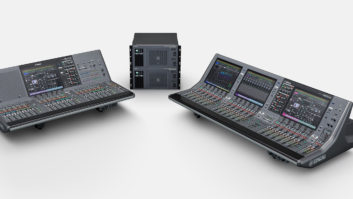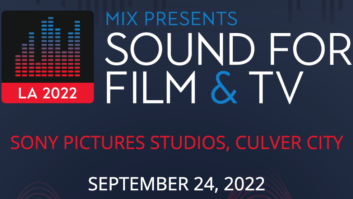Prism Sound ADA-8XR multichannel audio converters are being used to help the British Library digitise its collection of multitrack audio tapes in order to ensure the future of these valuable and historic recordings.
To tackle this project the British Library has acquired two more ADA-8XR converters, bringing the total number of units in its sound facilities to seven. It has also acquired a Prism Sound Orpheus interface.
Nigel Bewley, the British Library’s Operations Manager Sound & Vision, says: “We have a relatively small collection of 200 multitrack tapes and we think it will take about 20 weeks to complete this project, including the preparation of the resultant files, metadata compilation etc. We will also be using a third Prism Sound ADA-8XR converter, which we already own, to digitise 24 track tapes and to ingest all tracks simultaneously.”
Bewley adds that it is much more cost effective for the British Library to undertake this project in-house, rather than to out-house it. Also, by carrying out the work in-house, the British Library’s curators and content specialists can readily advise on the project.
“We use multiple ingest techniques with other analogue carriers such as tape and cassette,” Bewley explains. “The Prism Sound ADA-8XR units allow us to input 4 stereo channels or 8 mono channels (or any permutation) simultaneously. We use Prism Sound ADA-8XR converters because of their high audio quality. Furthermore they are 8 channel so support our multiple ingest workflows. Another important reason is that the Prism Sound ADA-8XR supports a wide range of sample rates including 32kHz. Once this project is completed, the new units will be used on other projects throughout our sound facilities.”
Multitrack tapes are notorious for their ability to degrade over time. In cases where the oxide is shedding they have to be ‘baked’ to return them to a stable condition so that they can be transferred onto a more secure medium.
“We do bake tapes when required and some of the multitrack tapes we are currently dealing with may need baking,” Bewley says. “The multitrack project is a preservation project – we want to preserve the individual tracks. Researchers may want to listen to just one track to hear a bass guitar part, for example, isolated from the mix. Many of the multitracks will have been mixed and made available as published CDs, LPs etc, but some have not, in which case we will need to work out how we are going to do a mixdown (if at all) for access purposes.”
The Sound Archive at the British Library is a resource with enormous national and historical importance. Its history can be traced back to 1905, when it was first suggested that the British Museum should have a collection of audio recordings of poets and statesmen. The Gramophone Company started donating metal masters of audio recordings, among them recordings by Nellie Melba, Adelina Patti, Caruso, Lev Tolstoy, Ernest Shackleton and Herbert Beerbohm Tree.
However, the British Museum was not maintaining a comprehensive archive and this worried Patrick Saul who, in 1955, started the British Institute of Recorded Sound. A public appeal was launched and thousands of shellac discs were donated, which started off the collection.
In 1983, the British Institute of Recorded Sound became part of the British Library, which had split off from the British Museum. Later renamed the British Library Sound Archive, it eventually acquired the metal masters originally collected by the British Museum when these were transferred to the Archive in 1992.
Situated near London’s Kings Cross, The British Library has 10 transfer studios and one recording studio, which is designed for speech recording. The audio suites are named after pioneers in audio technology and techniques from across the years and include Emile Berliner (1851-1929), Alan Blumlein (1903-1942), Thomas Edison (1847-1931), Fred Gaisberg (1873-1951), Michael Gerzon (1945-1996), George Gouraud (1841-1912), Arthur Haddy (1906-1989), Martin Hannett (1948-1991), Jean Jenkins (1922-1990), Joe Meek (1929-1967) and Alec Reeves (1902-1971).
All of the transfer studios are equipped with Digital Audio Workstations running SADiE or Wavelab and most also have Prism Sound ADA-8XR converters. The majority of these transfer suites are used for archival transfers but the rooms are also designed for more complicated transfer work, combined with restoration and editing, which is carried out by specialist audio engineers. The facilities have been used to train archivists from other organisations in audio archiving methodology and techniques.
“The larger studios have analogue kit to deal with a variety of formats,” Bewley explains. “We also have an Artefact Collection representing the history of recorded sound. We often ‘raid’ this collection to deal with obscure formats such as short-lived dictation formats, wire recordings, dictabelts and others. We also have a custom made cylinder player and we can deal with a wide range of legacy analogue formats, but we do have a wide range of digital kit, too.”
The British Library’s recording studio is used for podcasts, oral history interviews and audiobook recording for the British Library’s CD publication programme. Alongside its fixed facilities, the British Library has a busy location recording programme that takes in theatres, poetry and literary events, soundscape recording, wildlife, sound effect recording, oral history interviews in the interviewee’s home, workshops and seminars, music concerts and performances.
With such a wealth of recorded material in the archive, Nigel Bewley says real gems can be discovered when material is being transferred from one format to another.
“We recently discovered a collection of recordings made by the Swiss psychotherapist and psychiatrist Carl Jung that were made on wire during the 1960s,” he says. “Obviously it is very exciting when we unearth recordings like that – and it’s surprising how often it happens.”
-ends-
About Prism Sound
Founded in 1987, Prism Sound manufacture high-quality professional digital audio equipment for the International broadcast, film, music production, manufacturing and telecommunications sectors. The company’s product range includes the Prism ADA-8XR precision 8-channel converter unit, which is regularly used for music and film soundtrack projects by clients such as EMI Abbey Road, BBC, Sony, Lucasfilm and Walt Disney. Prism Sound also manufactures a range of audio test and measurement products, including the de facto standard DSA-1 handheld digital audio generator/analyser and the dScope Series III audio analyser system.
For more information: www.prismsound.com







